PORTFOLIO
BRIDGE TECHNOLOGY SERVICES
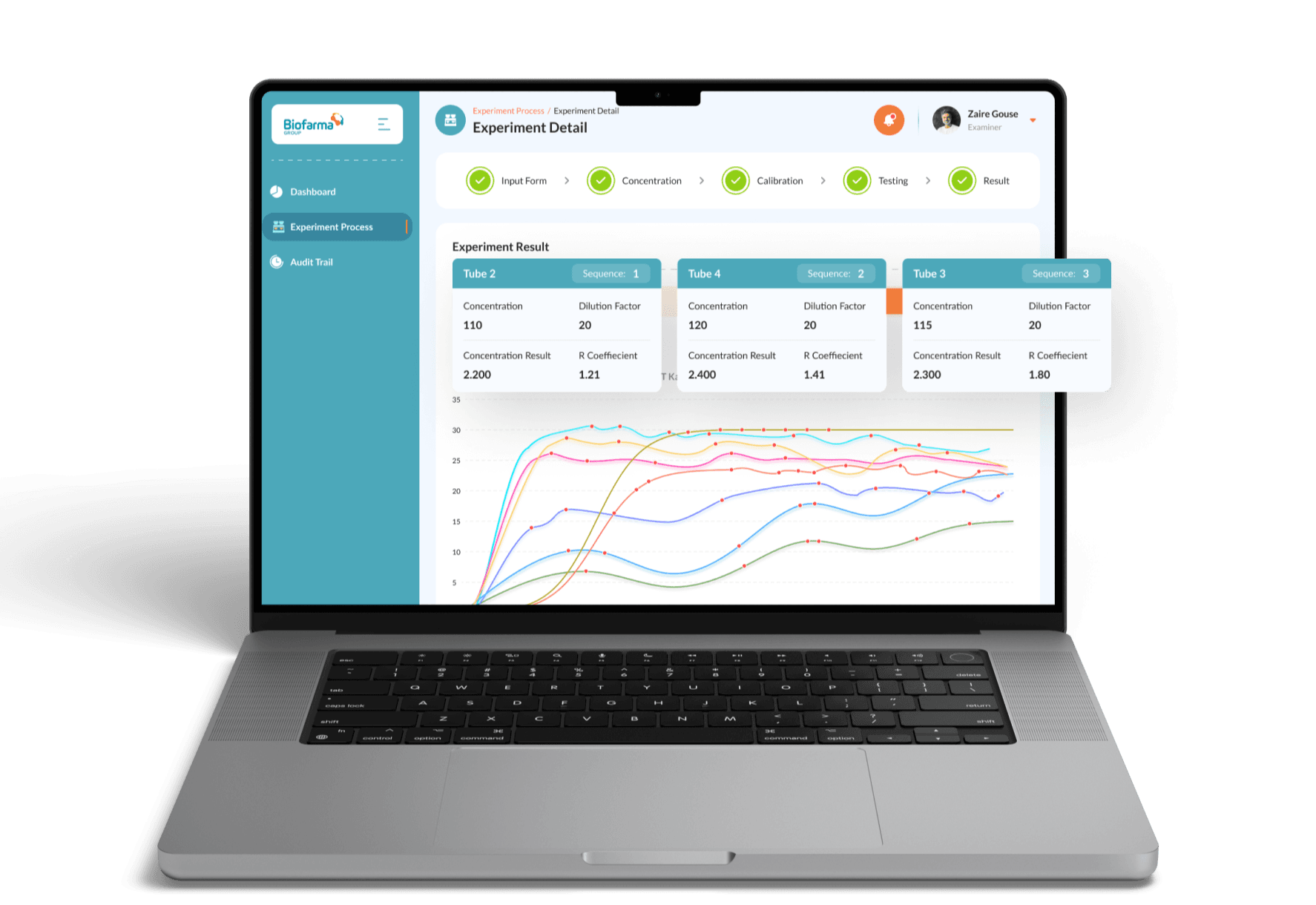
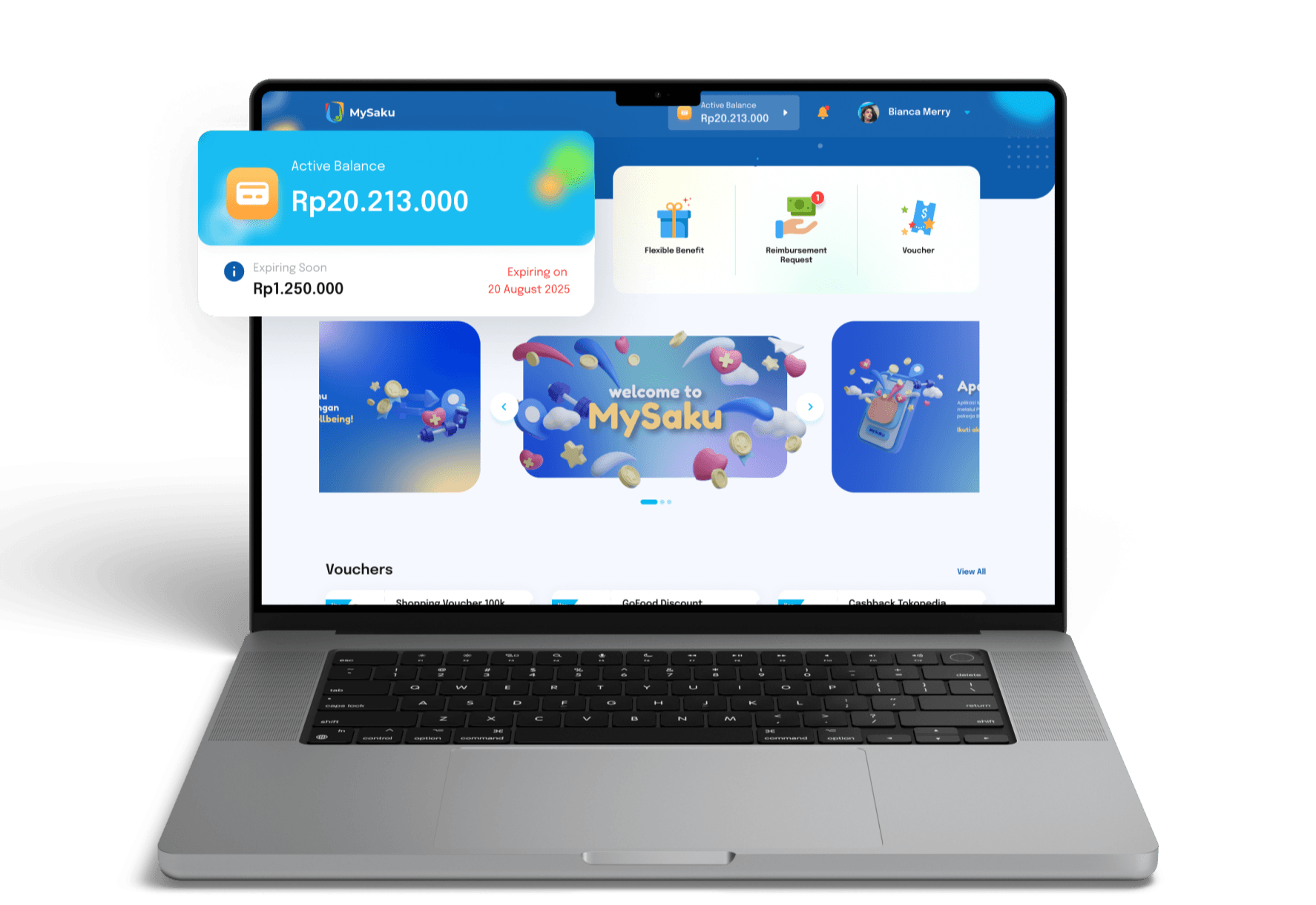
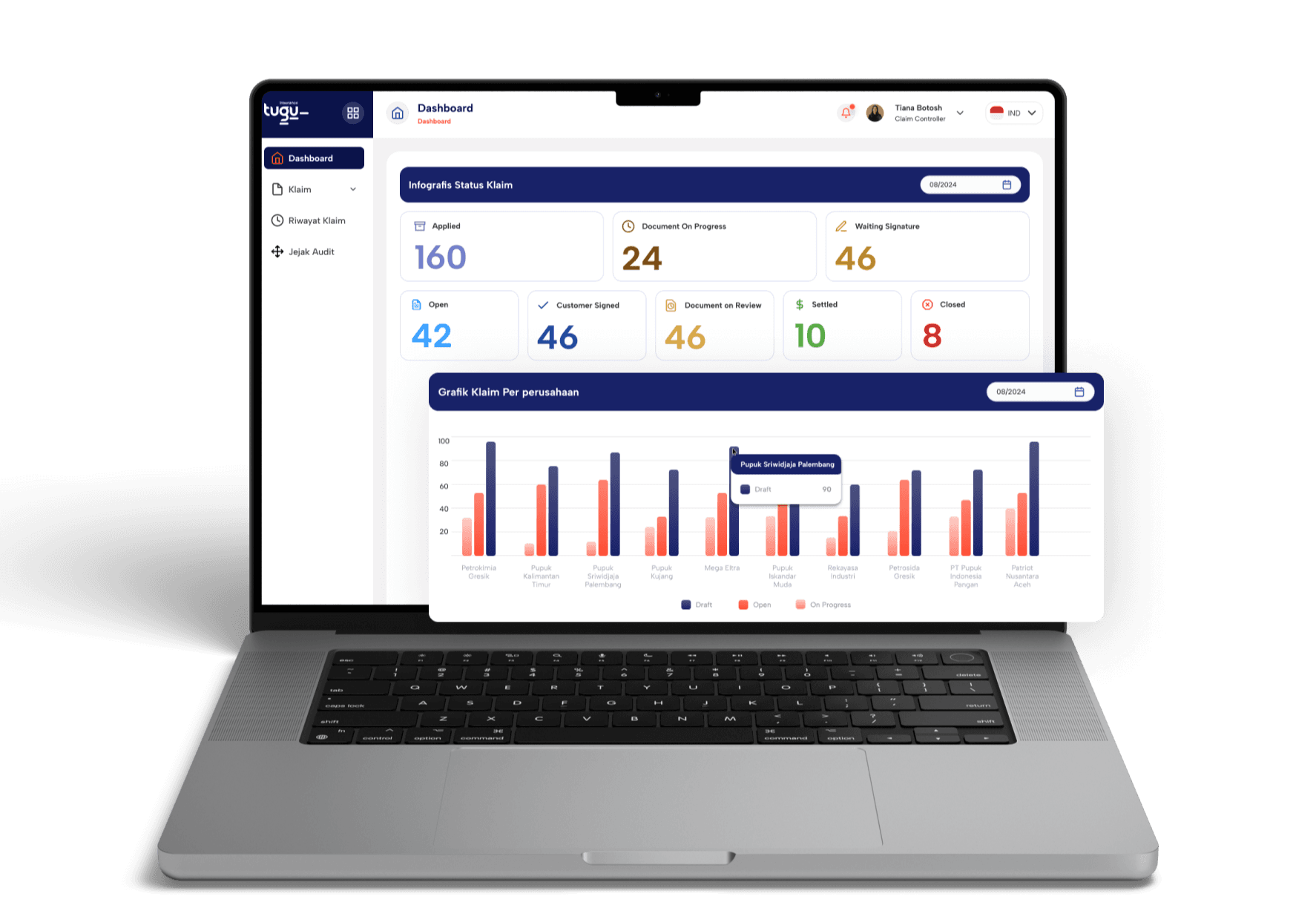
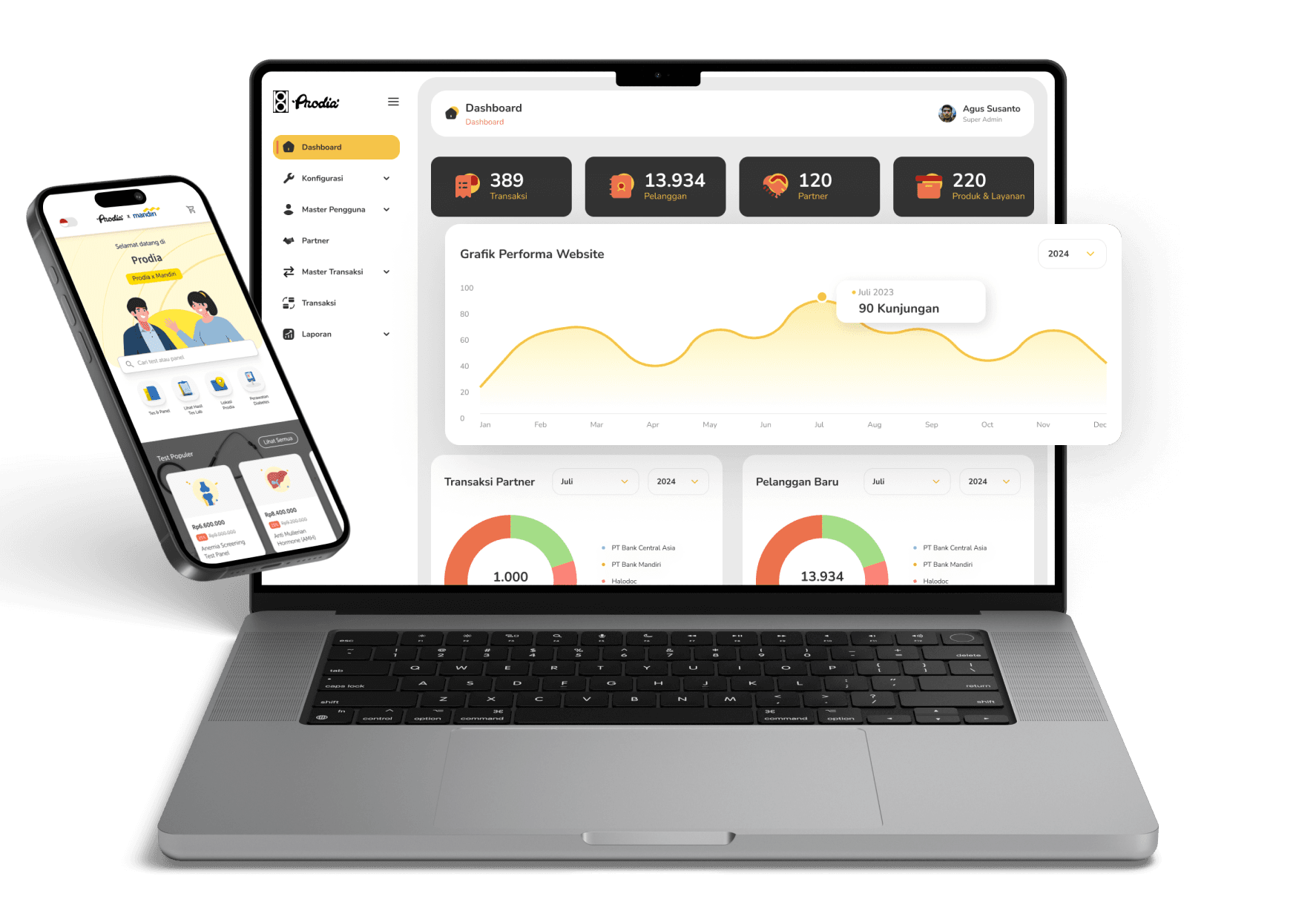

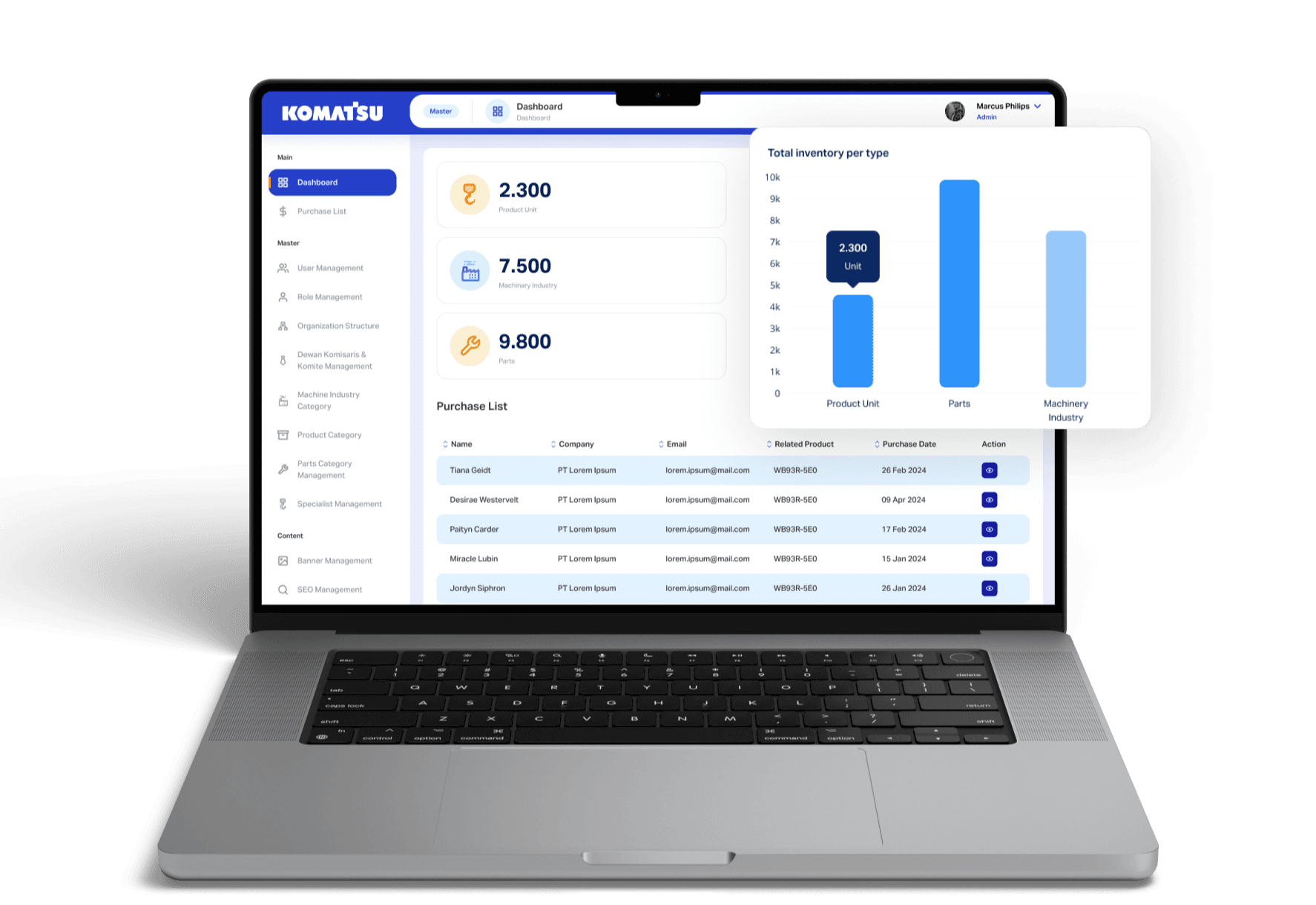
IT ENTERPRISE CONSULTANT
BRIDGE TECHNOLOGY SERVICES (BTS.id)
Is an Information & Communication Technology company by means of to-make-it-possible mindset. Using the most advance and suitable technology, we are able to develop and deploy a new vertical solution faster with the vast range of services for all industries. Established in 2008, we strive to develop and transform bricks-and-mortar business into the modern e-business with greater efficiency and effectiveness. As a software developer and publisher, we offer a solution to increase your company productivity using the latest technology.
0
ADEQUATE
EMPLOYEES
0
CLIENT
WORLD WIDE
0
SUCCESS
PROJECT
WE ARE
BRIDGE TECHNOLOGY SERVICES
Find out how companies are using our solution to step up their game in digital transformation.

The Latest Trends in Custom Software Development Every Company Should Know in 2026
In 2026, software development companies are positioned at the forefront of rapid digital innovation, playing a critical role in shaping how modern businesses operate and compete. As organizations encounter increasingly complex operational challenges and significantly higher user expectations, we are witnessing a major shift toward solutions that are not only smarter and faster, but also deeply integrated across ecosystems.
Generative AI is redefining how applications are built and optimized, cloud-native architecture ensures unmatched flexibility and scalability, hyperautomation streamlines processes end-to-end with unprecedented efficiency, and zero-trust security has become a non-negotiable requirement in protecting digital assets.
For software development companies, 2026 tech trends are more than just technological advancements, they represent a new standard in delivering value.
Clients now expect digital products that can evolve quickly, integrate seamlessly, and withstand constant security threats. This places development teams in a strategic position, not only to adopt new technologies, but to proactively guide businesses through digital transformation, helping them build future-ready systems that accelerate growth, improve resilience, and maintain a competitive edge in an ever-changing landscape.
The 2026 tech trends will have a significant impact on the evolution of software development.
The evolution of software development is a journey from the early days of computers to the modern era, marked by technological advancements and paradigm shifts. It refers to how the processes, technologies, and methods of software creation have continuously changed over time.
From writing machine code directly, it progressed to high-level programming languages, and now it is moving toward faster methodologies like Agile and DevOps, while integrating advanced technologies such as AI/ML, microservices, and low-code/no-code platforms.
The evolution of software development is closely linked to digital transformation, with both driving each other. Digital transformation requires companies to accelerate innovation, automate processes, and provide better digital experiences. To meet these demands, software development must evolve to become faster, more flexible, and smarter.
The digital transformation that necessitates software evolution will impact technological advancements such as AI, machine learning, cloud computing, IoT, robotics, and automation. These advancements make business processes faster, more efficient, smarter, and more connected. Companies can create new products, enhance services, and respond to market changes more effectively. Technological progress is a key driver of both digital transformation and the evolution of software development.
Some of the 2026 tech trends, which represent the latest custom software developments that every company should know in 2026, are:
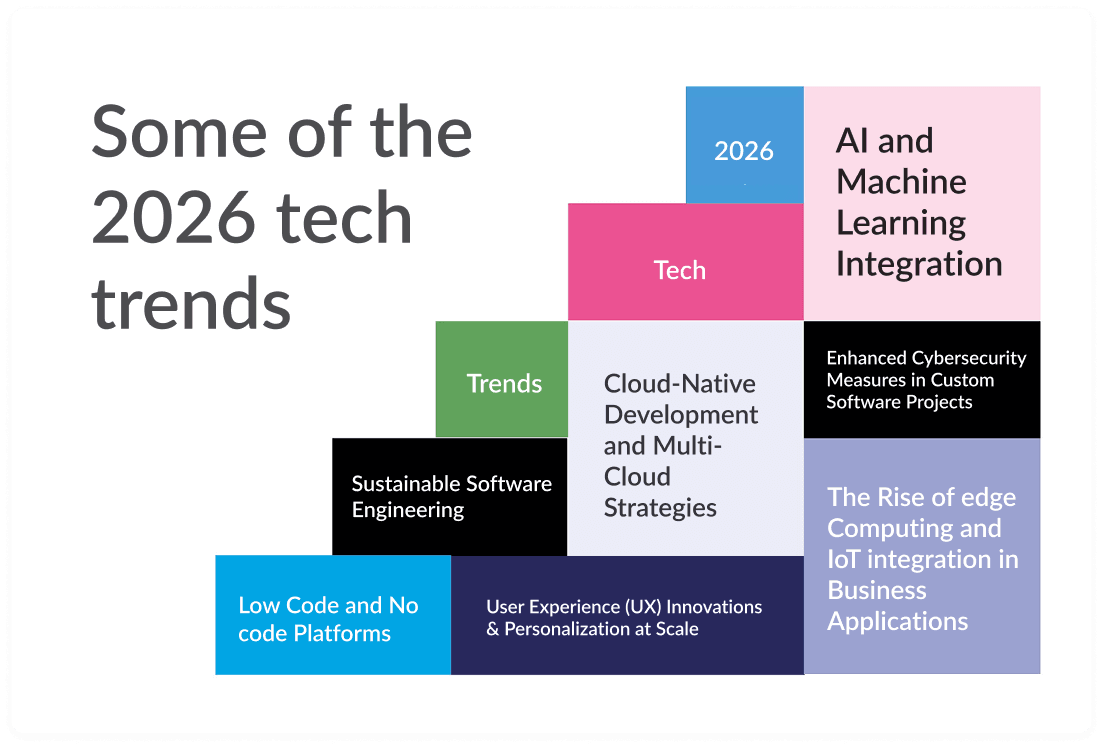
- AI and Machine Learning Integration: Shaping the Future of Custom Solutions
The integration of AI and machine learning into custom software solutions enables systems to become smarter, more automated, and capable of learning from data. This represents a transformative trend in the technology industry, where Artificial Intelligence (AI) and Machine Learning (ML) are no longer just additional features but core components of custom-designed software solutions tailored to meet specific business needs.
With these technologies, applications can:
• Predict user needs,
• Automate complex processes,
• Provide real-time recommendations,
• Improve the accuracy of business decisions.
Overall, AI and ML are shaping the future of custom solutions by delivering software that is more personalized, efficient, adaptive, and data-driven, making businesses more competitive in the digital era.
The four elements that from the core, mutually supportive components in AI and machine learning integration are as follows:- AI in Custom Software
Provides intelligence to applications, enabling software to understand context, analyse data, and respond intelligently. - Machine Learning Applications
Allows software to learn from data continuously improve accuracy and performance over time. - Intelligent Automation
Automate processes with AI/ML-based decision-making capabilities, rather than merely following static rules. - Predictive Analytics
Use ML algorithms to predict trends, risks, and future needs, making software more proactive.
- AI in Custom Software
- Low Code and No code Platforms: Accelerating Application Delivery
Low code and no code platforms are technologies that enable application development with minimal coding (low code) or even no coding at all (no code). These technologies will become highly important in 2026 as businesses increasingly demand applications that are fast, flexible, and easily customizable.
These platforms help businesses accelerate innovations, improve internal processes, and respond to market needs without waiting for lengthy development projects. In short, low code/no code offers an effective way to speed up application delivery in the 2026 era.
In shaping the modern application development ecosystem in 2026, there are four related elements:- Low Code Platforms 2026: Low code platforms provide visual tools and ready-to-use components, allowing developers to write minimal code. By 2026, these platforms will become the standard for accelerating enterprise software projects.
- No Code App Builders: Used by non-technical users to create applications without coding. They are an essential part of the low code/no code trend, expanding internal innovations capabilities within companies.
- Rapid Application Development (RAD): Low code and no code directly support RAD, a methodology focused on building applications very quickly, with instant prototyping and rapid iteration.
- Citizen Developers: These are users who leverage no code or low code to build applications, including:
• Operational staff,
• Marketing,
• Finance,
• HR.
• Product managers.
They can create their own solutions without waiting for the IT team.
These four elements accelerate innovation together, reduce the developer’s workload, and enable companies to release applications faster in 2026.
- Cloud-Native Development and Multi-Cloud Strategies
Cloud native development is an approach to building applications directly in the cloud environment using technologies such as microservices, containers, and serverless computing. This approach makes applications more scalable, faster, and easier to update.
Meanwhile, multi cloud on a single vendor, increase flexibility, and ensure systems remain operational even if one service experiences downtime.
Both trends are important in 2026 because they help companies build applications that are more resilient, efficient, and ready to grow in line with modern business needs.
The four interconnected components that form a modern cloud modernization ecosystem in 2026 are:
• Cloud Native Apps: A new way to build modern applications.
• Serverless Architecture: A part of cloud native that makes development more efficient.
• Multi Cloud Solutions: A deployment strategy that maximizes flexibility and resilience.
• Cloud Migration Trends 2026: The main driver prompting companies to adopt cloud native and multi cloud models.
These are key pillars that help businesses build applications that are more scalable, flexible, and future-ready in the 2026 era.
- Enhanced Cybersecurity Measures in Custom Software Projects
In 2026, security will be a top priority in custom software development. Companies are increasingly implementing advanced protections such as end-to-end encryption, multi layer authentication,
AI-based threat detection, and compliance with global standards. The goal is to protect sensitive data, prevent cyberattacks, and ensure applications are secure from design through deployment.
The following four key components are the main focus for modern companies:- Cybersecurity Best Practices 2026
The latest standards, such as zero trust, AI-based threat detection, end to end encryption, and continuous monitoring, ensure applications remain secure against evolving to achieve. - Secure Software Development Lifecycle (SSDLC)
Security is integrated into every stage of development. With SSDLC, vulnerabilities can be identified faster, mitigation costs are lower, and compliance is easier to achieve. - Data Privacy Regulations
Global and regional regulations require companies to handle data securely and transparently.
This drives the implementations of privacy by design, strict access controls, and regular audits in custom software. - Threat Detection Tools for Custom Solutions
AI/ML based tools help detect anomalies, block threats in real time, and provide proactive protection against modern attacks.
In 2026, security must be a foundational element of custom software development. By combining best practices, SSDLC, privacy compliance, and threat detection technologies, companies can build secure, modern solutions ready to face the risks of the digital world.
- Cybersecurity Best Practices 2026
- The Rise of Edge Computing and IoT integration in Business Applications
Edge computing processes data directly on devices or near the source, rather than in the cloud, making applications faster, more responsive, and efficient. When combined with IoT (Internet of Things), businesses can manage smart devices, sensors, and machines in real time.
This trend is important in 2026 because it helps companies enhance automation, accelerate decision making, and create smarter, more connected business applications.
• Edge computing trends 2026: Data processing closer to devices for high speed and efficiency.
• IoT-enabled solutions: Interconnected smart devices and sensors supporting business automation.
• Real-time data processing: Businesses can make instant decisions through rapid analytics at the edge.
• Connected devices integration: Integrating various devices for smarter, more responsive operations.
Edge computing accelerates data processing, IoT provides a network of data generating devices, and their integration allows companies to create smarter, more responsive, and scalable applications. The year 2026 will be an era where businesses rely on these technologies to improve efficiency, automation, and real time decision making capabilities.
- User Experience (UX) Innovations and Personalization at Scale
In 2026, UX innovation is no longer just about attractive design, but about how applications deliver truly relevant experiences for each user. Technologies such as AI, machine learning, and data analytics enable companies to create personalization at scale without compromising performance.
UX innovations provide more intuitive interfaces, adaptive navigation, and more human-like interactions.
Meanwhile, personalization at scale uses real time data to automatically tailor content, recommendations, and features to the needs of each user.
• UX design trends 2026 drive applications to be more intuitive, minimalist, and responsive, focusing on user comfort.
• Personalized user interfaces for custom apps leverage AI and real-time data to display content, recommendations, and layouts tailored to each user’s needs.
• Customer-centric development strategies ensure the entire development process focuses on the user experience, aligning personalization with UX innovation.
These elements create custom applications that are more personal, relevant, and satisfying, serving as a key business differentiation in 2026.
- Sustainable Software Engineering: Green IT Initiatives Gaining Momentum
Sustainable software engineering is an approach to custom software development that focuses on energy efficiency, reducing carbon, footprints, and using more environmentally friendly resources. By 2026, more companies are adopting Green IT initiatives such as optimizing cloud infrastructure, writing energy efficient code, and designing efficient architecture to reduce power consumption.
The goal is to create software that is lighter, more efficient, and sustainable, while supporting corporate environmental targets.
• Sustainable software practices 2026: Focus on reducing carbon footprints and improving energy efficiency in application development.
• Green coding techniques: Writing lightly, resource efficient code that minimizes computational waste.
• Energy efficiency application design: Application architectures that optimize the use of servers, cloud resources, and devices.
The practices create software that is more efficient, environmentally friendly, and sustainable.
- Navigating Regulatory Compliance in a Changing Digital Network
In the 2026 tech trends, companies must adapt to new regulations related to data, security, and privacy. Software development now needs to consider standards such as GDPR, PDPA, HIPAA, or other local regulations.
The goal is to ensure applications are secure, legally compliant, and able to adapt to continuously evolving regulations, helping businesses avoid legal risks and data breaches.
• Software compliance requirements 2026: The latest software compliance requirements in 2026 demanding stricter security, privacy, and data management.
• GDPR updates for developers: GDPR updates that developers must understand to ensure applications comply with privacy standards and user data protection.
• Industry specific regulations for bespoke software: Industry specific rules (healthcare, finance, government, etc) that must be applied in custom software.
Together, these form a modern compliance framework that companies must follow to keep custom software secure, legal, and regulation-ready in constantly changing digital work.

To face 2026, companies need to embrace innovation to stay relevant and competitive. Future-proofing your business with 2026 tech trends means preparing your business by following trends such as AI, cloud native, IoT, and modern cybersecurity, making systems more adaptive and ready for rapid changes.
Meanwhile, staying competitive through innovation adoption emphasizes the importance of strategically adopting new technologies not just following trends, but truly integrating them into business processes and software development.
The outcome is that organizations can build smarter, more efficient, and sustainable custom solutions while maintaining a competitive position in an increasingly dynamic digital era.
Digital transformation is no longer optional. It is a necessity.
With the latest trends such as AI/ML, cloud-native, low-code/no-code, and modern cybersecurity, companies ready to innovate will lead the market.
Take the first step now: contact our team at BTS.id for strategic consultation and discover how custom software solutions can support your company’s sustainable business growth.

Software Development Company Uncovers How 2026 AI Will Revolutionize Business Operations
Entering 2026, artificial intelligence (AI) continues to evolve from merely a supporting tool into a core foundation of global digital transformation that Software development companies must certainly adapt to this 2026 tech trend. Development such as generative language models, intelligent process automation, more efficient machine learning, and AI’s growing ability to understand context are becoming increasingly mature.
The Evolution of AI towards 2026 is making artificial intelligence increasingly smarter, autonomous, and integrated into nearly every business process, from automation and analytics to decision making. What once considered an experimental technology has now become the backbone of digital strategies across companies, public institutions, and research organizations. AI applications are now present in nearly every domain, from customer communications and process automation to executive-level decision making support.
AI is no longer making processes longer only, it is beginning to shape how businesses make decisions, innovate, and create more personalized customer experiences.
This directly impacts how software development companies operate, the service they offer, and the value they deliver to clients.
Some of these impacts include:
- Building software that is already prepared for and compatible with AI technologies
- Accelerating development processes using AI-powered tools
- Offering AI solutions to clients (chatbots, automation, data prediction)
- Ensuring software architecture is flexible and scalable for future

Some of the key drivers behind the 2026 AI development trends are:
- Machine Learning
In this case, advancements in machine learning are the primary force behind AI development trends in 2026. Larger, more efficient ML models that can understand various types of data (text, images, audio, video) will make AI in 2026:
• Smarter and more versatile
• Able to run on small devices (edge all)
• Cheaper and faster to use
• Increasingly automated through AI agents
• Safer and more transparent due to a stronger focus on Responsible AI
The advancement in Machine Learning today shapes how AI will work, evolve, and be utilized in the 2026 tech trend.
- Predictive Analytics
Predictive analytics is a key driver of AI trends in 2026 because it enables AI to automatically predict behaviors, needs, and risks. This makes systems more proactive, quicker in decision making, and capable of working in real time.
For software development companies, this capability is crucial because businesses increasingly need applications that can provide automatic recommendations, predict demand or risks, and optimize processes based on data.
In short, predictive analytics is the foundation of AI in 2026, and software development companies have to be able to integrate it so their products remain relevant and competitive.
- Software Development Innovations
Software development innovations are closely tied to AI trends in 2026, as the software development process is becoming increasingly automated, faster, and smarter thanks to AI development. Applications being built must also be AI-ready and easy to integrate with analytics, automation, and AI models.
For software development companies, this means they have to use AI to accelerate coding and testing, build applications that are ready for AI integration, and offer AI-based solutions to remain competitive.
Software development innovation is being driven by AI in 2026, and software companies need to adapt, or risk being left behind.

Businesses need AI to operate faster and smarter, which means they require custom software and enterprise applications built with AI features such as prediction, automation, and analytics. From this need, automation tools emerge to simplify operational processes.
All of this has become an essential part of digital transformation strategies, as companies shift toward more efficient, data driven systems that are ready for the future.
Several related elements, AI integration in business, custom software development, enterprise AI apps, automation tools, and digital transformation strategies, are interconnected as a unified technology ecosystem in 2026.
- AI Integration in Business
AI integration becomes the main foundation for businesses in 2026.
Businesses need AI to:
• Increase efficiency
• Gain deep insights from data
• Enable automated decision-making
This drives the demand for software that is AI-ready.
- Custom Software Development Solutions
Because every business has unique needs, companies require custom software development that:
• Supports AI
• Can process real-time data
• is scalable for future technologies
This means software development companies have to build solutions that are natively AI-ready.
- Enterprise AI Apps
Large companies no longer want ordinary applications, they want enterprise-grade apps equipped with
AI capabilities, such as:
• Predictive analytics
• Process automation
• Intelligent recommendations
• Real-time monitoring
• AI agents for daily operations
All of these become part of custom enterprise solutions.
- Automation Tools
Automation tools are a direct result of AI integration.
In 2026 tech trend, automation tools include:
• Workflow automation
• Customer automation
• Operational automation
• Software development automation (AI coding/test)
These innovations increase productivity and operational efficiency for businesses.
By 2026 tech trend, Artificial Intelligence (AI) is predicted to become an essential foundation in core business operations, no longer just an auxiliary tool. Its main impacts will include increased efficiency, smarter datadriven decision-making, and fundamental transformation of business models. The year 2026 is expected to be a turning point for companies that integrate AI into their core strategies. The following trends are likely to determine success or failure in future business competition.
- Generative AI and Multimodality
Generative AI is no longer limited to producing text, it can now generate images, video, audio, and various other types of output within a single system (multimodal), while also leveraging synthetic data and simulations for product development and testing. This technology has a significant impact on businesses, from accelerating and personalizing marketing content, simplifying prototyping and market testing through synthetic data, to creating more immersive customer experiences.
- Edge AI & Smart IoT
Edge AI is the process of performing artificial intelligence computations directly on local devices such as sensors, cameras, or IoT devices, instead of always relying on the cloud, by leveraging advanced sensors and low-latency networks. This enables real-time response, reduces bandwidth and communication costs, and enhance data privacy and security since data does not need to be transmitted off the device
- AI Infrastructure Focused on Inference
This shift marks a move from heavy investment in training AI models to leveraging pre-trained models for continuous, real-time predictions. The inference process becomes a critical part of daily business operations, from serving users and processing transactions to running automation and responding to customers, where performance, speed, and cost efficiency heavily depend on how this process is managed.
- Process Automation and Collaborative AI Agents
Intelligent automation, which combines RPA (Robotic Process Automation) and AI with support from multi-agent systems capable of collaborating to complex workflows automatically, is applied across various business functions such as back-office operations, finance, logistics, inventory, and document processing, as well as customer service through AI agents. These agents can understand context from multiple data sources, take action, and coordinate across modules such as chatbots, voice systems, and recommendation engines.
- Focus on Cost Efficiency and AI ROI
This trend arises because many companies have adopted AI but have yet to achieve optimal results. As a result, business focus is now shifting toward measuring ROI and creating real value through targeted strategies, such as starting with pilot projects before scaling, applying AI to areas with the greatest challenges, and optimizing operational efficiency through automation of repetitive tasks.
Industry specific artificial intelligence (AI) applications are revolutionizing various sectors by providing tailored solutions for specific challenges, enhancing operational efficiency, and driving innovation. These advanced AI solutions from predictive maintenance in manufacturing to faster medical diagnostics in healthcare are fundamentally changing the way businesses operate.
This means that more sophisticated AI technologies are being applied specifically across industries to improve efficiency, productivity, and innovation.
Example include:
- Healthcare: AI assists in faster diagnoses, reading medical scans, and predicting diseases.
- Finance: AI is used for fraud detection, risk analytics, and customer service automation.
- Retail: AI development predicts demand, personalizes product recommendations, and optimizes inventory management.
- Manufacturing: AI automated productions, monitors machinery, and prevents breakdowns (predictive maintenance)
- Transportation & Logistics: AI plans optimal routes, predicts delivery needs, and supports autonomous vehicles.
- Education: AI enables adaptive learning tailored to each student’s needs.
AI is not only used in general applications but is also customized for the specific needs of each industry, driving significant transformations in how these sectors operate.
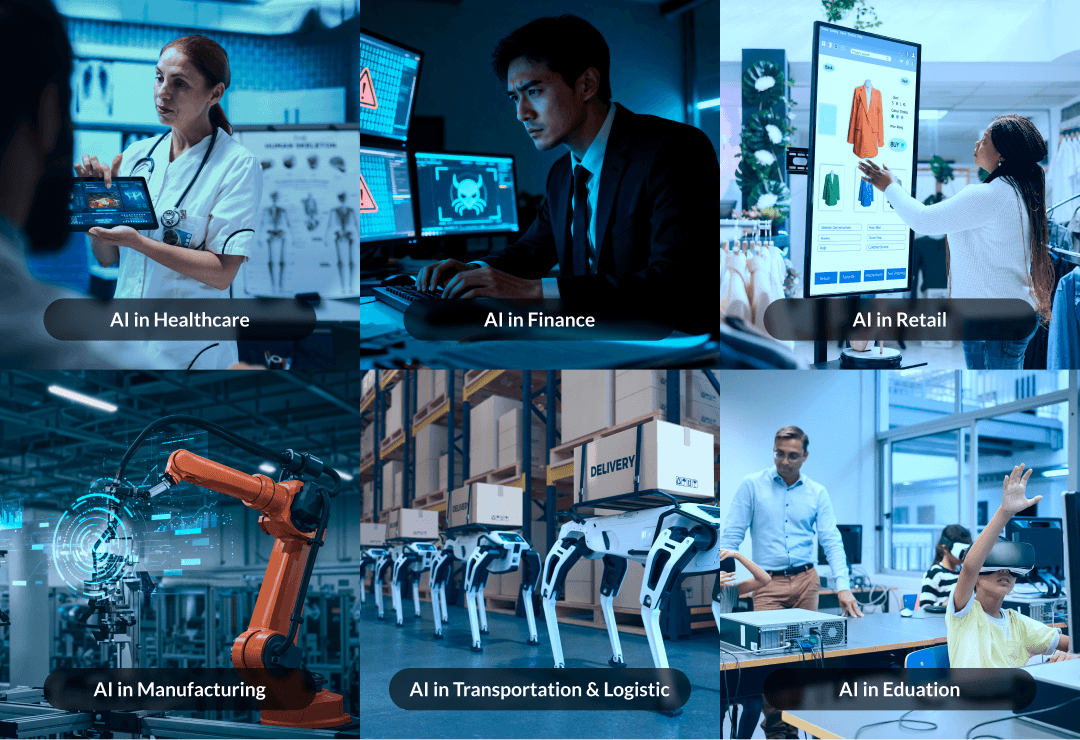
The adoption of next generations AI, especially generative AI, brings significant challenges related to security and ethics. Addressing these challenges is crucial to ensure responsible and sustainable use of the technology.
In other words, it involves examining the challenges companies or industries face when adopting the latest AI technologies, particularly concerning security and ethics.
- Security
The cybersecurity landscape is entering a new phase, much faster, more ruthless, and uncompromising.
While a few years ago organizations felt safe with monthly patch schedules, today that pace is no longer sufficient.
The speed of attacks surpasses what humans can counter, and by 2026, analysts predict this trend will reach its peak, ushering in an era of machine-speed security. Next generation AI introduces risks such as:
• Leakage of sensitive data
• Cyberattacks leveraging AI
• Model manipulation (e.g., data poisoning)
• Use of AI without strong privacy safeguards.
Companies must ensure that AI is safely deployed and that data is protected.
- Ethics (Ethical Considerations)
Ethics is a set of moral principles that help us distinguish right from wrong. AI ethics is a multidisciplinary field that studies how to maximize the beneficial impact of AI while minimizing risks and harmful outcomes.
Ethical use of artificial intelligence (AI) means ensuring that it is developed and applied responsibly to support humanity, respect human dignity and rights, and minimize risks of discrimination and misuse.
Ai must be used responsibly, including:
• Avoiding bias in algorithms
• Ensuring AI decisions are explainable (explainable AI)
• Maintaining transparency in how AI operates
• Ensuring AI does not harm users
• Complying with global ethical standards and regulations
- Responsible AI Implementation in Business Operations
Implementing AI responsibly requires a strategic approach focused on ethics, transparency, and risk mitigation. The key strategies include developing a clear ethical framework, ensuring transparency and accountability and prioritizing data security and privacy.
To use AI safely, ethically, and effectively, businesses should adopt the following strategies:- Transparency & Explainability
Ensure AI operations are explainable (explainable AI) so that AI decisions can be understood by internal teams and customers. - Data Protection & Privacy
Apply high security standards, encryption, and clear privacy policies. User data must be safeguarded against misuse. - Bias Elimination
Regularly audit AI models to ensure they do not introduce biases against customers or specific groups. - Regulatory Compliance
Ensure AI adheres to laws and regulations, such as data protection, AI ethics, and applicable industry standards. - Human-in-the-Loop
Maintain human involvement in critical decision making to avoid full dependence on AI. - Continuous Monitoring & Evaluation
Continuously monitor AI performance to detect errors, anomalies, or data changes that may affect outcomes. - Ethical Data Usage
Only use data obtained lawfully and with clear consent. - AI Systems Security
Protect models from threats such as data manipulations attacks, model hijacking, and unauthorized access.
- Transparency & Explainability
Preparing Your Business For the Future Through AI-Driven Software Integration
Integrating artificial intelligence (AI) into your software solutions is a strategic step toward achieving efficiency, innovation, and competitive advantage.
Future-Ready Business Strategies with AI Solutions
This means designing company plans and operations that leverage AI to address technological changes, evolving customer needs, and market dynamics in the coming years. With AI development, businesses can automate operational processes, making work faster and more efficient. AI also supports more accurate decision-making through predictive analytics and real-time data. From the customer perspective, AI enhances experiences by providing faster, more personalized, and relevant services.
Additionally, AI solutions open opportunities for new product and service innovations that create added value for the company. The technology also strengthens business resilience by predicting risks, detecting anomalies, and helping companies adapt more quickly to market changes. Overall, AI-driven strategies help businesses remain relevant, competitive, and ready for the digital future.
Digital Competitiveness through AI Adoption by Software Companies
This refers to a company’s ability to gain a market edge by leveraging AI in their products, services, and internal processes. By integrating AI, software companies can build smarter, more efficient, and automated solutions from data-driven applications and predictive analytics systems to automation platforms that enhance client productivity.
AI also accelerates innovation, enabling companies to respond to market trends faster and create more relevant products. Additionally, using AI in internal processes such as software development, automated testing, and bug detection improves product quality while reducing operational costs. Overall, AI adoption becomes a crucial foundation for software companies to remain competitive, attract more customers, and lead in the era of digital transformation.
Preparing for Technological Disruption in Business Operations
This means ensuring that companies are ready to adapt when new technologies emerge that significantly change workflows, operational processes, and business models. Technological disruption such as AI, automation, IoT, and machine learning can accelerate processes, reduce costs, or even replace outdated and efficient methods.
To navigate these changes, businesses need flexible systems, a willingness to innovate, and enhanced digital capabilities within their teams. Companies must also leverage new technologies to optimize workflows, mitigate risks, and improve customer service. With this readiness, businesses can not only survive amidst change but also capitalize on new opportunities and strengthen their competitive position in the market.
In the era of the 2026 AI Revolution, technology is evolving at an unprecedented pace, and businesses are required to adapt faster than ever. Partnering with a visionary software development company is a strategic move, as they possess the expertise to effectively integrate AI into your systems, products, and business operations.
Innovative development companies not only understand the latest AI trends but can also design solutions that are scalable, secure, and aligned with industry needs. With their support, businesses can accelerate digital transformation, increase efficiency, create better customer experiences, and unlock new growth opportunities.
Ultimately, such partnerships help companies not just survive technological change but lead the competition and thrive in an increasingly complex digital landscape.
Looking for higher efficiency, intelligent automation, and competitive advantage?
Start your AI journey with us BTS.id team. Let's create AI solutions tailored to your business needs. Consult your project today with our BTS.id team.

Indonesian Software Development Company: Custom Software Development Ready for 2026 Tech Trends
New year brings new challenges and new enthusiasm for business and technology players who must keep pace ever-evolving innovations. This is especially true for software development companies, where custom software development must continuously adapt to emerging technology trends to stay relevant and support faster business processes in the digital era.
Technological progress toward 2026 is accelerating rapidly, driven by the rise of autonomous artificial intelligence (AI), enhanced connectivity, and the convergence of multiple innovations. As 2026 approaches, the technology landscape continues to evolve at an unprecedented pace. According to 2026 tech trend reports, the rapid advancement of new technologies in the coming decade promises a revolution across all sectors.
Instead of progressing gradually, these changes will occur exponentially, where each technological breakthrough fuels further innovation across industries. From artificial intelligence (AI) to the interconnectivity of the Internet of Things (IoT), these trends hold immense potential to revolutionize industries and enhance the overall quality of life, reshaping the way we live, work, and interact with the world around us.
Let's examine some key aspects that illustrate the rapid development of technology towards 2026:

- Voice and Conversational AI
AI technology is now taking the lead in the tech world. Beyond professional applications, AI has become both a shortcut and a trend in everyday life. Its human-like nature and ability to adapt to user needs make AI an effective time saving tool. This early advancement is set to become a major breakthrough in 2026, evolving into intelligent virtual assistants for businesses.
Some examples include:
• Acting as customer service agents to handle basic inquiries or complaints.
• Assisting with office tasks such as data analysis, summaries, and conclusions.
• Taking meeting notes.
• Generating ideas and supporting brainstorming sessions.
• Developing into voice bots for automated communication.
Therefore, integrating voice and conversational AI is highly recommended as part of your company’s digital transformation strategy for 2026.
- Personalized Marketing with AI
CRM (Customer Relationship Management) applications are already widely used across many companies. With the advancement of AI technology in 2025, CRM systems can now be integrated with AI to further accelerate business processes.
Some of the key benefits include:
• Analyzing customer behavior based on purchase history and search patterns.
• Providing customer preferences through predictive insights.
• Helping marketing and sales teams focus on the hottest leads for retargeting.
By adopting this 2026 tech trend, your marketing and sales teams can focus more strategy, communication, and direct customer engagement, enabling smarter and more personalized business growth.
- AIoT (Integration of AI + IoT)
The Internet of Things (IoT) connects electronic devices to the internet, making it easier for people to interact with technology in their daily lives. Examples include smartwatches, CCTV cameras that can be monitored remotely, and automatic light sensors that turn on at night.
By 2026, combining IoT with AI will significantly enhance its capabilities, making business operations smarter and more efficient.
When your company adopts AIoT, it becomes easier to monitor systems remotely and perform multitasking, as real-time alerts will automatically notifications whenever an issue arises. This integration not only improves efficiency but also helps organizations respond proactively to challenges in their operations.
- Trying Virtual Products with AR (Augmented Reality)
The rise of e-commerce has successfully transformed traditional shopping experiences that once required customers to visit stores and try products in person. Today’s e-commerce platforms offer a variety of features from customer reviews and package tracking to live streaming that allows real-time interaction between buyers and sellers.
Although Augmented Reality (AR) is not a new feature, only a few brands have adopted it so far. In fact, AR can significantly enhance user experience by allowing customers to virtually try products before purchasing, a key step that brings them closer to making a buying decision.
By implementing AR, businesses can not only improve customer satisfaction but also boost engagement and conversion rates in an increasingly competitive digital marketplace.
- Cybersecurity in a Hyperconnected World: Emerging Threats and Evolving Solutions
As our reliance on technology grows and the world becomes increasingly interconnected, the need for robust cybersecurity solutions has never been more critical. By 2026 tech trend, we can expect a significant rise in sophisticated cyberattacks targeting critical infrastructure, businesses, and individuals.
Some key impacts and solutions include:
• Cybersecurity Investment: Companies and governments must prioritize investment in advanced cybersecurity measures.
• AI-Powered Threat Detections: Implement AI-driven systems to detect and respond to threats in real-time.
• Zero-Trust Security Model: Adopt a zero-trust framework to minimize vulnerabilities across systems.
• Individual Awareness: Encourage individuals to protect their personal information online.
• Safe Digital Hygiene: Promote secure digital practices as part of everyday online behavior.
In this hyperconnected era, cybersecurity is not just a technical necessity, it’s a strategic foundation for building trust, ensuring resilience, and protecting the digital future.

In the rapidly evolving digital era leading up to 2026, technology has become the core foundation for every company striving to survive and grow. Amid these transformations, custom software development emerges as a key element for global businesses seeking to stay competitive.
Unlike off-the-shelf software, which offers generic functionalities, custom software is specifically designed to match each organization’s unique needs, workflows, and goals.
This tailored approach enables companies to build systems that fully support their strategy and long term vision.
One of the main advantages of custom software development lies in its flexibility and efficiency. Every feature can be customized to fit internal workflows, helping to streamline processes, reduce errors, and boost team productivity. Moreover, custom software can be seamlessly integrated with existing systems, creating a more unified and efficient digital ecosystem.
Beyond improving efficiency, custom software development also helps organizations enhance productivity by automating critical processes. Smooth system integration allows business to create a connected digital environment, strengthening collaboration and enabling faster, data-driven decision making.
From a security and scalability perspective, custom software gives companies full control over their systems.
Solutions can be designed to meet strict security standards and developed to grow alongside the business without disrupting ongoing operations.
Moreover, custom software development opens significant opportunities for innovation. By creating unique features and distinctive user experiences, businesses can establish a competitive advantage that is difficult for competitors to replicate.
Software development companies in Indonesia are now in a unique and strategic position to deliver futureready solutions. With a combination of highly skilled tech talent, competitive development costs, and deep understanding of global market needs, Indonesia has emerged as one of the most promising digital innovation hubs in Southeast Asia.
Supported by advances in digital infrastructure and the growing adoption of technologies such as AI, IoT, Cloud Computing and Data Analytics, software development companies in Indonesia are able to deliver solutions that are not only aligned with current business needs but also robust and adaptive to future technology trends.
An approach focused on collaboration, flexibility, and innovation makes Indonesian software developers ideal partners for global companies looking to accelerate their digital transformation with efficient, secure, and sustainable solutions.
Evolutions from Standard Software to Personal, Adaptive, and Scalable Systems
Rapid technological advancements have driven a major transformation in the world of software development.
While companies once relied heavily on generic, off-the-shelf software, the trend has now shifted toward more personalized, adaptive, and scalable solutions tailored to modern business needs.
Here are some stages of this evolution:
- From General Solutions to Greater Flexibility
Initially, standard software was chosen because it was easy to implement and had a relatively low upfront cost. However, as businesses grow and operational complexity increases, many organizations realize that generic solutions are no longer sufficient. Limitations in flexibility and customization lead companies to seek approaches that better align with their specific needs.
- Personalization as a Key Value Add
The rise of custom software development addresses this challenge. Each feature and module is designed to support a company’s unique workflows and strategies. This approach provides added value through higher efficiency, as the system is fully aligned with the organization's internal processes.
- Adaptability to Respond to Change
In a constantly evolving business environment, whether in terms of market trends, regulations, or technology, adaptability is a key factor. Adaptive systems allow companies to adjust to new developments without undergoing major overhauls, making the organization more resilient and ready to face technological disruptions.
- Scalability for Long-Term Growth
Sustainable business growth requires scalable systems. This means the system can expand alongside increasing users, data, or new features without compromising performance. Such an approach allows companies to broaden their business reach without the need to replace the entire digital infrastructure.
- Towards Intelligent and Integrated Systems
The next stage of this evolution is the creation of smarter, integrated systems that leverage technologies like AI, IoT, cloud computing, and data analytics. Software is no longer merely an operational tool but a strategic foundation that drives innovation, efficiency, and data-driven decision-making.
In this fast-paced digital era, businesses can no longer rely on traditional, stand-alone systems. Integration with modern technologies such as artificial intelligence (AI), cloud services, and real-time analytics is now a key requirement for maintaining competitiveness and operational efficiency.
Here’s the explanation:
- Artificial Intelligence (AI) for Smarter Decision-Making
AI has transformed the way companies operate by delivering automation and data-driven insights.
Through machine learning and predictive analytics, businesses can understand customer behaviour, predict market trends, and optimize internal processes. AI integration helps companies make faster and more accurate decisions, while reducing reliance on manual processes.
- Cloud Services for Flexibility and Efficiency
Cloud computing provides incredible flexibility for modern businesses. With cloud-based systems, companies can store, manage, and access data or applications from anywhere, regardless of device or location. In addition to reducing infrastructure costs, cloud services also enable real-time cross-team collaboration and easy scalability as the business grows.
- Real-Time Analytics for Rapid Response
In a competitive business world, real-time data is a critical asset. Integration with real-time analytics systems allows companies to monitor performance, customer behaviour, and market conditions in realtime, enabling them to respond quickly to changes. This approach helps companies make more relevant and targeted data-driven decisions.
- Integration as the Foundation of Digital Transformation
When AI, Cloud, and real-time analytics work together, companies can build intelligent, interconnected digital ecosystems. The result is increased productivity, cost efficiency, and greater innovation capabilities.
In other words, technology integration is no longer an option, but a strategic necessity. Companies that can harness the potential of AI, cloud, and analytics in an integrated manner will have a competitive advantage in facing future challenges and opportunities.
By 2026, software will become a strategic element that directly influences business direction, from decisionmaking and product innovation to customer experience.
Supported by technologies such as AI, data analytics, and automation, software will help companies identify new opportunities, accelerate growth, and create a competitive advantage in the global marketplace.
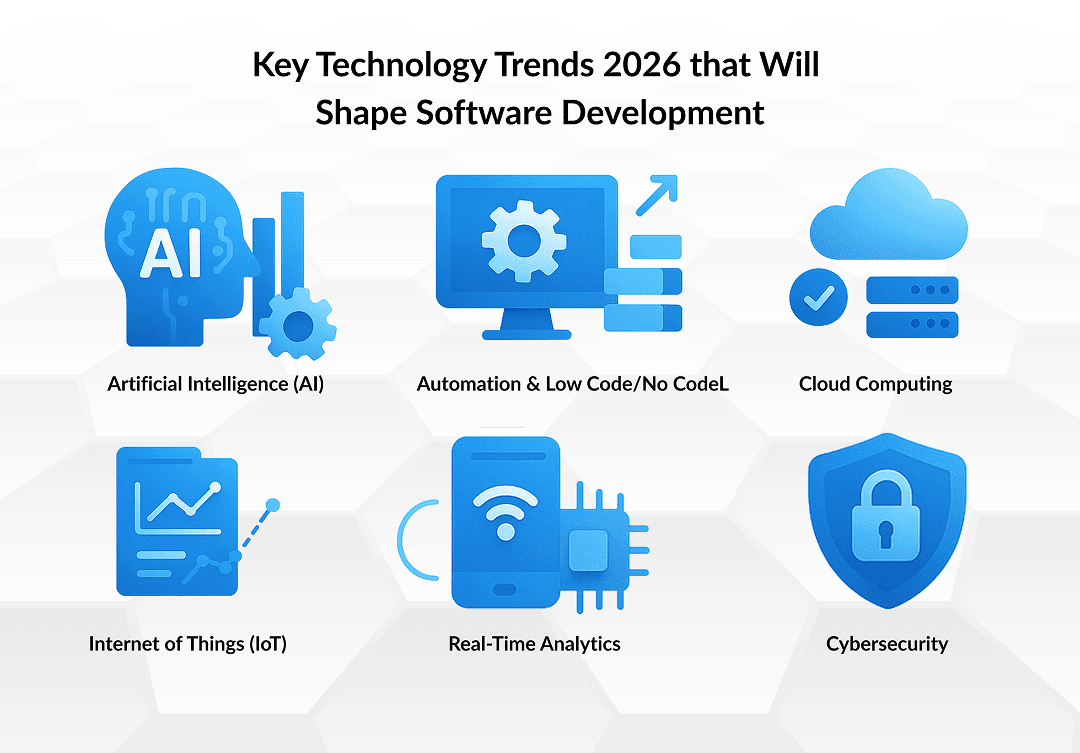
Key Technology Trends 2026 that Will Shape Software Development
As we approach 2026, the technology landscape continues to evolve rapidly, impacting how companies develop and utilize software. The following key technology trends are expected to play a decisive role in shaping the direction and strategy of software development in the future.
- Artificial Intelligence (AI): Delivering intelligent automation, predictive analytics, and data-driven decision-making.
- Automation & Low Code/No CodeL: Accelerating the application development process with greater efficiency.
- Cloud Computing: Providing flexibility, scalability, and ease of cross-location collaboration.
- Internet of Things (IoT): Connecting physical devices with digital systems for real-time solutions.
- Real-Time Analytics: Enables business to make quick decisions based on real-time solutions.
- Cybersecurity: A top priority with an AI-based protection system.
These trends indicate that future software development will become increasingly intelligent, adaptive, and integrated, making technology a key driver of business strategy.
Why Should You Choose a Software Development Company from Indonesia?
Choosing an Indonesian software development company offers many strategic advantages.
Here’s an explanation:
- High quality Talent
Indonesia has a large pool of professional software developers with expertise across various fields, from AI and mobile apps to cloud computing. - Competitive Development Costs
High quality work combined with cost efficiency compared to many other countries makes Indonesia an ideal choice for outsourcing or global collaboration. - Global Market Understanding
In Indonesia, many Indonesian software development companies have experience working with international clients, giving them a deep understanding of global business needs and standards. - Professional Standards and Agile Practices
In Indonesia, the use of Agile methodologies, transparent communication, and a results-focused approach makes projects more efficient and easier to manage. - Commitment to Security and Quality
Many companies in Indonesia implement international-grade security and quality controls to ensure product reliability. - Strategic Time Zone for Asia-Europe-US Coordination
With manageable time differences, Indonesian software developers can efficiently bridge communication across multiple time zones, enabling smoother global collaboration.
Custom software development enables businesses to create solutions that are tailored to their needs, flexible to technological changes, and ready to face future challenges. This approach allows companies to adapt faster, increase efficiency, and remain competitive in a continuously evolving digital era.
- Discovery: This stage ensures that solutions are built based on a deep understanding of business needs and goals, making the software truly relevant and strategically valuable.
- Design: System and interface designs are created to be efficient, user-friendly, and capable of adapting to evolving technology trends.
- Agile Development: The agile approach allows for flexible development, rapid adaptation to feedback, and continuous evolution in line with changing requirements.
- Scalability: Solutions are developed to grow alongside the business, handling increases in users, data, and integration with new technologies in the future.
This approach also includes integration with modern technologies such as AI, data analytics, and automation to ensure that the solutions developed are truly future-ready.
- AI helps improve efficiency and data-driven decision-making
- Analytics provides real-time insights to support smarter business strategies
- Automation accelerates operational processes and reduces human error.
By incorporating these three elements into every stage, from discovery to scalability, custom software development becomes more adaptive, efficient, and future-oriented, supporting sustainable digital transformation.
In a rapidly changing era, digital solutions must do more than meet current needs. Software should be designed to be easily updated, integrated, and enhanced, keeping pace with advancements such as AI, automation, IoT. and data analytics.
With a flexible and scalable foundation, custom software can continuously evolve, ensuring that businesses remain relevant, competitive, and prepared for future technological challenges.
As we move into 2026, technology will continue to advance rapidly, and only businesses that adapt through digital innovations will thrive.
Partnering with an Indonesian software development company means building solutions that are not only relevant today but also resilient and future-ready, as 2026 tech trends demand smarter and more adaptive software.
Indonesian companies are well-positioned to meet these needs by combining innovation and efficiency in every solution they develop. By establishing long-term partnerships, businesses can achieve sustainable digital growth and confidently embrace the future.
Ready to take your business into the digital era of 2026?
Partner with BTS.id, an Indonesian software development company dedicated to delivering innovative, efficient, and future-oriented custom solutions.
Contact BTS.id today and begin your journey toward sustainable digital transformation.
Let’s build your next custom software project designed for 2026 and beyond, and long-term success!

Why Global Companies Choose Indonesian Software Development Companies for AI Projects
In recent years, the world has witnessed a significant surge in the adoption of Artificial Intelligence (AI) across various industries. AI powered software has now become an essential element in global digital transformation strategies, helping software development companies innovate faster, work more efficiently, and make smarter, data-driven decisions.
Artificial Intelligence (AI) is radically transforming the software development process by introducing tools and techniques that enhance productivity, accuracy, and drive innovation.
The global demand for AI-based software continues to grow in line with the acceleration of digital transformation across multiple sectors.
Businesses, from small enterprises to large corporations, are leveraging AI to improve operational efficiency, understand customer behaviour, and make more intelligent. data-driven decisions.
Technologies such as machine learning, natural language processing, and computer vision are increasingly being implemented in business solutions from process automation to the development of innovative products.
This trend demonstrates that AI is no longer just an additional innovation, but has become a core component of global growth and competitiveness strategies.
The demand for AI-based software is rapidly increasing as many organizations strive to improve efficiency, productivity, productivity. and decision-making capabilities.
Some of the key factors include:
- Global Digital Transformation: Companies across various sectors are racing to adopt technology to automate processes and enhance customer experience.
- Abundance of Data: The surge of data from digital activities, IoT, and social media creates vast opportunities for applying machine learning and predictive analytics.
- Advancements in Computing Technology: Access to more affordable cloud computing and GPUs has made AI implementation increasingly accessible.

The growing global demands for AI-based software has become one of the main drivers behind the surge in outsourcing and nearshoring practices within the software development industry.
Companies across various sectors are now racing to integrate AI into their systems but are facing challenges related to talent availability, costs, and development speed.
This is where the role of outsourcing and nearshoring becomes increasingly vital.
More and more companies around the world are choosing outsourcing or nearshoring for software development because these strategies offer efficiency, flexibility, and access to high quality global talent.
Why is that? Here’s the explanation:
- Cost Efficiency
One of the main reasons companies choose outsourcing is to reduce operational costs. By partnering with development teams from other countries with lower labor costs, companies can allocate their budgets to other business areas such as product innovations, marketing, or market expansion.
Nearshoring (outsourcing to geographically closer countries) also helps minimize logistics and communication costs without sacrificing efficiency.
- Access to Global Talent
The shortage of skilled professionals in technology, especially in software and AI development, has led companies to seek solutions abroad.
Through outsourcing of nearshoring, businesses can access experienced developers with specialized expertise, ranging from cloud computing and mobile development to cybersecurity, without the need for lengthy recruitment processes.
- Focus on Core Competencies
By delegating the development process to technology partners, companies can concentrate their internal resources on core activities such as business strategy, customer service, or product innovation.
This approach enhances productivity and accelerates time to market for new products.
- Scalability and Flexibility
Outsourcing offers companies a high level of flexibility to scale development teams up or down according to project needs.
This is especially beneficial in the dynamic technology industry, where project requirements can change rapidly.
- Nearshoring: A More Effective Collaboration Solution
Unlike traditional outsourcing, nearshoring enables easier collaboration due to similar time zones and work cultures.
This helps accelerate communications, reduce coordination barriers, and maintain the quality of development outcomes.
The growing global demand for AI-based software is driving Indonesia to become not only a potential market but also a producer of technological solutions.
Many local startups and AI software development company have begun developing AI-based solutions for various sectors, including finance, education, healthcare, and logistics.
This demonstrates that Indonesia is no longer merely adopting foreign technologies but is now actively contributing to creating digital innovations with global value.
Indonesia’s position as a leading technology hub in Southeast Asia has become increasingly strategic, establishing the country as one of the most dynamic tech centers in the region.
The rapid growth of the digital economy, the rise of innovation driven startups, and government support for digital transformation have made Indonesia an increasingly significant player in the global technology landscape.
Why Indonesian software development companies stand out?
Indonesian software development companies are gaining greater recognition on the international stage. With a combination of creative young talent, competitive developments, costs, and continuously advancing technological capabilities, Indonesia has successfully positioned itself as one of the leading software development hubs in Southeast Asia.
Here are some of the reasons:
- Competent and Adaptive Digital Talent
Indonesia has a large and growing base of digital talent.
Many young software developers possess expertise in modern technologies such as:
• Artificial Intelligence (AI) and Machine Learning
• Mobile and Web Development
• Cloud Computing and DevOps
• Cybersecurity
In addition, Indonesian developers are known for being highly adaptable to new technologies and quick to adjust to global market demands.
- Competitive Development Costs
One of Indonesia’s greatest advantages is its more cost efficient development rates compared to Western countries or even several other Asian nations.
This makes Indonesia an ideal destination for foreign companies seeking to outsource or nearshore their projects without compromising on quality.
- High work Quality and Professional Standards
An increasing number of Indonesian AI software development companies are adopting internationally recognized development practices, such as:
• Agile and Scrum methodologies
• Continuous Integration/Continuous Deployment (CI/CD)
• Rigorous Quality Assurance (QA)
Many companies also maintain a global portfolio with clients from the United States, Europe, and
Australia, demonstrating that the quality of their work is internationally recognized.
- Collaborative and Communicative Culture
Another advantage of Indonesian companies is their strong collaboration and communication skills.
Indonesian development teams are accustomed to working across time zones and cultures, enabling them to build productive working relationships with global clients,
Their professional, flexible, and service-oriented attitude is an added value that makes clients feel comfortable and confident in working together.
- Time Zone Advantage
Geographically, Indonesia is located in a strategic time zone, situated between Asia, Australia, and parts of the Middle East, making it ideal for cross-border collaboration.
This advantage allows Indonesian companies to:
• Provide faster technical support (real time support)
• Maintain 24-hour project productivity with a staggered workflow across time zones.
• Minimize communication barriers and waiting times, which are often challenges in long distance outsourcing projects.

In today’s fast-paced digital era, software quality and security are two of the most critical aspects for business success.
Software development companies in Indonesia (software house) now focus not only on delivering functional end results but also on ensuring that every solution they develop is secure, stable, and compliant with international standards.
Here’s how they maintain quality and security at every stage of development:
- Implementation of International Standards in the Development Process
Many Indonesian software development companies have adopted global standards such as:
• ISO/IEC 27001 for information security management
• ISO 9001 for quality management systems, and
• OWASP top 10 as a guideline for web application security
By implementing these standards, companies can ensure that every process from requirement analysis to deployment is carried out in a structured, measurable manner and in accordance with international best practices.
- Use of Agile and DevOps Methodologies
To maintain quality and efficiency, development teams in Indonesia widely employ Agile and DevOps methodologies.
• Agile enables continuous testing, allowing bugs or errors to be detected early.
• DevOps integrates development and operations teams, ensuring that the process from development and testing to deployment is fast while remaining secure and stable.
This approach results in products that are more flexible, reliable, and of high quality.
- Rigorous Quality Assurance (QA)
Every professional software development company has a Quality Assurance (QA) team responsible for ensuring the quality of each feature and module.
The QA process typically includes:
• Automated testing (unit tests, integration tests, regression tests)
• Manual testing for user experience (UI/UX)
• Performance testing to ensure application stability under high load
QA is not only conducted at the end of a project but is an integral part of the entire development lifecycle (SDLC)
- Security as a Priority from the Start (shift-Left Security)
The ‘shift-left security’ principle has now become a common practice in many Indonesian software development companies.
This means that security is not only considered at the end of a project but is implemented from the design and early development stages.
Measures taken include:
• Encrypted code and regular security audits
• Penetration testing to identify system vulnerabilities
• Implementation of two-factor authentication and encryption of sensitive data
With this approach, security risks can be minimized early, making the product far more resilient to cyber threats.
- Use of Modern Technologies and Tools
Software development companies in Indonesia in their efforts to deliver custom software solutions also leverage modern tools and frameworks to maintain quality and security, such as:
• SonarQube for code quality analysis
• Jenkins or GitLab CI/CD for automated testing and deployment
• Docker & Kubernetes for managing consistent and secure environments
The use of these technologies helps ensure that every application version is stable, tested. and easily traceable.
Quality and security are not just add-ons but the fundamental foundation of every modern software solution.
Indonesian software development companies have proven that they can combine technical expertise, global standards, and professional work ethics to deliver products that are secure, reliable, and competitive in the global market.
As the global demand for AI-based software continues to grow, many businesses are now seeking development partners capable of delivering innovative and impactful AI solutions.
With its rapidly growing technology ecosystem and competent digital talent, Indonesia has become a key destination for outsourcing or collaborating on AI development.
However, to ensure the success of your project, choosing the right software house is a crucial step.
Here are some tips to help you:
- Evaluate AI Experience and Portfolio
The first step is to review the company’s experience in handling AI-based projects.
Check whether they have a relevant portfolio, such as:
• Development of machine learning or deep learning systems
• Application of AI in data analytics, forecasting, or business process automation
• Integration of AI with IoT, mobile applications, or enterprise systems
Tips: Choose a company that not only ‘builds AI’ but also understands how AI can deliver real added value to your business.
- Check Technical Expertise and Technologies Used
AI development requires a strong combination of technical skills.
Ensure that the development team is proficient in:
• Programming languages such as Python, R, or JavaScript
• Popular AI frameworks like TensorFlow, PyTorch, or Scikit-learn
• Cloud infrastructure such as AWS, Google Cloud, or Azure AI Service
Experienced software houses are usually also capable of providing an end-to-end pipeline, from data engineering to mode; deployment.
- Consider the Quality of the Team and Local Talent
One of Indonesia’s main advantages is its abundance of globally qualified digital talent.
However, it is still important to assess whether the team handling your project has:
• Experienced AI specialist or data scientists
• Engineers who understand your business domain
• Communication and collaboration skills across time zones (time zones advantage)
The combination of technical expertise and soft skills will be a key factor in the success of your AI project.
- Communication and Transparency
AI projects require intensive communication between technical and business teams.
Ensure that the company has a clear and regular communication systems such as:
• Weekly sprint meetings or progress reports
• Access to real-time project dashboards
• Quick response to feedback
Transparent collaboration will accelerate decision-making processes and reduce miscommunication.
- Choose a Partner Who Understand Both Technology and Your Business Goals
This is a factor that is often overlooked, yet it is crucial.
Choose a partner who is not only technically skilled but also understands your business vision and objectives.
Why is this important?
• A successful AI project is not just about using advanced algorithms but about how the technology addresses real business needs.
• A partner who understands the business context can translate your company strategy into relevant technological solutions.
• They can also help you optimize your technology investment so that the outcomes truly deliver financial and operational impact.
For example, instead of immediately building a machine learning model, they would first analyze how an AI solution can enhance your business performance, such as production efficiency, customer experience, or market demand forecasting.

Indonesia now holds a significant position on the global technology map, particularly in software development and AI-based solutions.
With a combination of high quality digital talent, competitive development costs, and a continuously growing technology ecosystem, Indonesia offers strategic value that is hard to match in Southeast Asia.
Software development companies in Indonesia not only excel in technical capabilities but also increasingly understand the global business context, making them ideal partners for companies seeking to build innovative, secure, and high value AI solutions.
Additionally, the time zone advantage aligned with Asia and Australia, along with flexible communication with international clients, makes Indonesia a prime choice for long-term collaboration on advanced technology projects.
By choosing an Indonesian software house as your partner, your business gains more than just a development team, you gain a strategic partner ready to help drive digital transformation, improve efficiency, and accelerate AI adoption on the global scale.
In positioning Indonesia as a strategic partner for software development and AI-based solutions, there are four main advantages that form the foundation of success: quality, efficiency, innovation, and trust.
These four key pillars make Indonesia an increasingly significant player on the global stage:
- Quality: Adhering to international standards such as ISO and OWASP, with rigorous testing processes to ensure reliable and secure outcomes.
- Efficiency: Competitive development costs and smooth collaboration thanks to strategic time zones and responsive teams.
- Innovation: Actively developing AI, cloud, and IoT-based solutions, continuously experimenting to create new business value.
- Trust: Known for transparency, professionalism, and strong commitment to data security and client satisfaction.
With these four pillars, Indonesia is increasingly recognized as a trusted technology and AI development partner for global-scale digital projects and AI innovation.
Partnering with Indonesian developers means investing in the digital future of your business.
With technical expertise, continuous innovation, and a commitment to quality and integrity, Indonesian software houses are ready to become long-term strategic partners, helping you achieve sustainable success in the era of digital transformation and AI.
Indonesia has proven itself as a mature technology ecosystem, also outsourcing Indonesia has advanced and grown significantly.
with a unique combination of high work quality, cost efficiency, continuous innovation, and global professionalism.
With qualified talent, ongoing innovation, high flexibility, and a commitment to security and professionalism, development companies in Indonesia are capable of supporting your business growth alongside technological advancements.
This partnership ensures that you have digital solutions that are relevant, efficient. and adaptable, making Indonesia an ideal strategic partner in your journey of digital transformation and global AI innovation.
Ready to grow?
Let’s find the right software development company for your business partner with an Indonesian software house that understands your business needs and is ready to grow alongside you.
You can contact us at BTS.id, a trusted Indonesian software development company, ready to support your business in growing and thriving toward the future.
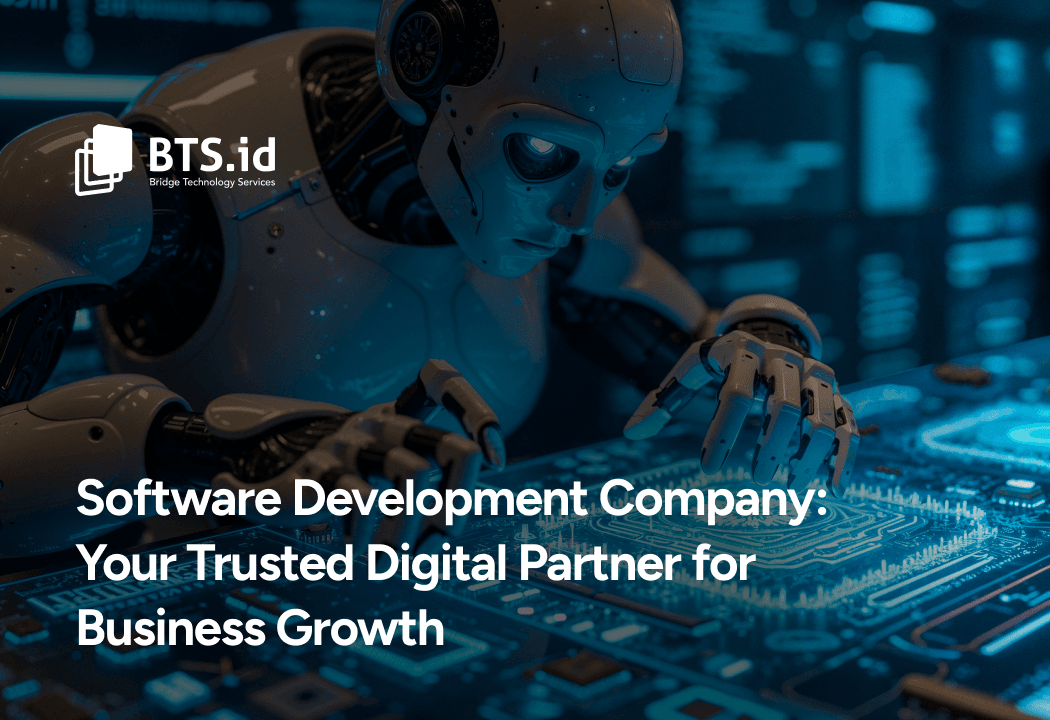
Software Development Company: Your Trusted Digital Partner for Business Growth
As software becomes increasingly integral to everyday life, software developers are starting to play a vital role in companies across various industries. Moreover, with the rapid acceleration of the digital era, technology is evolving quickly, and almost every aspect of our lives is now integrated with different types of software. From software developers more essential than ever both business and users.
A software development company is a business organization engaged in the design, development, testing, distribution, and maintenance of software products, ranging from customer applications, business solutions, to custom software tailored to client needs. These companies come in various types, such as consumer software developers (games and social media apps), enterprise software developers (ERP and CRM systems), as well as modifying existing ones to meet customer needs.
In short, a software development company acts as a digital partner that helps businesses innovate, improve efficiency, and grow through technological solutions.
Why do businesses need a software development company?
Businesses need software development companies because technology has become the backbone of nearly every industry today.
They rely on software development companies to obtain customized solutions, enhance efficiency and productivity, create competitive advantages, integrate existing systems, and strengthen security and compliance.
A software development company brings specialized expertise to build unique applications tailored to a business’s specific needs, often providing more effective and efficient solutions than off-the-shelf software.
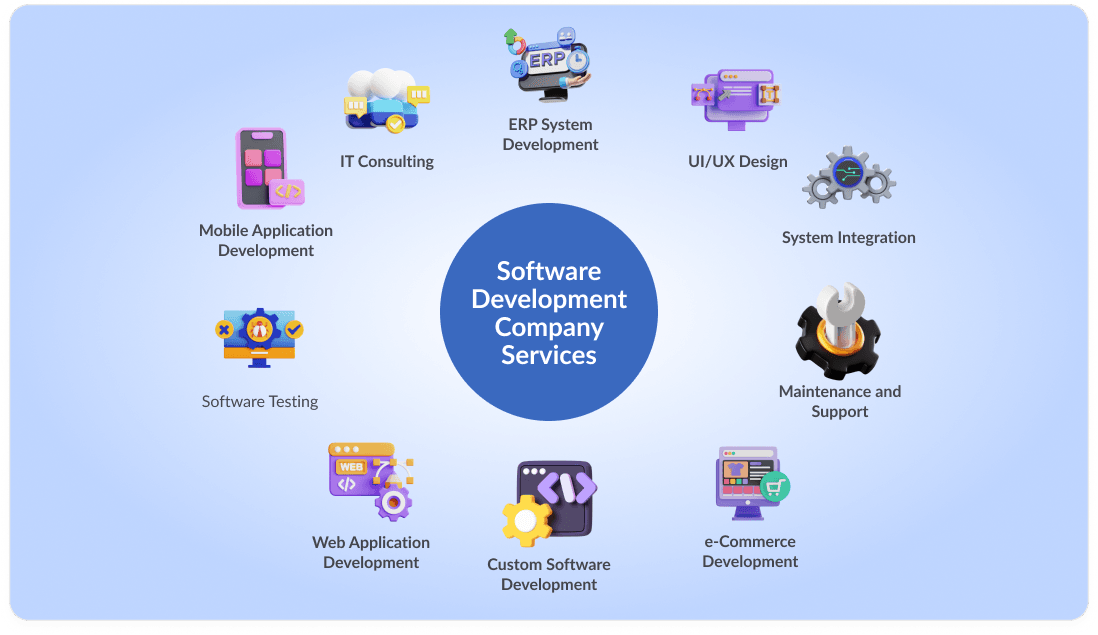
So, what services can a software development company offer?
Here are some of the main services typically provided by software developments companies:
- Custom Software Development
One of the key services offered is custom software development. A service that creates software tailored to the specific needs of clients.
Example: A custom inventory management system designed to handle the logistics requirements of a manufacturing industry. - Web Application Development
This service builds web-based applications that can be accessed through an internet browser.
Example: A project management platform for teams to collaborate and manage tasks online, such as Trello. - Mobile Application Development
Another key service offered is mobile application development.
A service that develops applications for mobile platforms such as iOS and Android.
Example: BCA Mobile or Mandiri online, which allows users to perform banking transactions from their mobile devices. - System Integration
A service that combines different systems and software to function in a unified way.
Example: Integration between a Customer Relationship Management (CRM) system and an Enterprise Resource Planning (ERP) system to automate data flow between sales and inventory management. - Maintenance and Support
Maintenance and support is the next key service offered.
Provides maintenance and support services to ensure software runs smoothly.
Example: Maintenance services for an e-commerce system to keep the website secure, functional, and regularly updated. - Software Testing
This service conducts testing to ensure the quality and performance of the software meet the desired standards.
Example: Mobile app testing services to check for bugs, security, and performance before the app is released on Google Play or the App Store. - IT Consulting
This service offers advice and strategies on effective technology implementation.
Example: Consulting for a company’s digital transformation process, including recommendations for the best software, IT infrastructure, and strong cybersecurity strategies. - ERP System Development
This service focuses on building Enterprise Resource Planning to manage various business processes.
Example: ERP systems such as SAP or Odoo, which integrate business functions like finance, human resources, production, and distribution. - UI/UX Design
This service aims to design intuitive and engaging user interfaces and user experiences.
Example: User design for streaming apps like Netflix to ensure users have an enjoyable experience while easily navigating the platform. - e-Commerce Development
This service builds e-commerce platforms for online sales.
Example: E-commerce platforms like Tokopedia or Bukalapak, which enable sellers to open stores and sell their products to consumers.

In the digital era, technology is no longer just a support tool, but has become the main foundation for business growth. To remain competitive and continue evolving, companies need the right technological support.
This is where software development companies serve as strategic partners.
Partnering with a software house is not only about creating applications but also delivering real benefits for businesses that aim to innovate and expand their reach.
Through this collaboration, businesses can combine specialized knowledge, pool resources, and accelerate the creation of new products.
The main benefits of working with a software development company as follows:
- Ensuring Quality and Expertise
The first benefit of partnering with a software house is access to skilled professionals with extensive experience in various technologies and programming languages.
They can be trusted to deliver accurate, high-quality, and innovative solutions tailored to your business's specific needs. - Saving Time and Costs
Developing software in-house requires significant investments in terms of time, cost, and human resources.
By using the services of a software company, you can save time and costs for recruitment and training, as the provided team is already trained and ready to work. - Ability and Focus on Core Business
By outsourcing software development to a software house, you can focus on your core business aspects without being distracted by the technical complexities and project management of software development.
This allows you to allocate resources and attention to business growth and key strategies while ensuring that your core competencies remain the priority. - Customized Solutions
Every business has unique needs. A software house can design custom applications that truly address your company’s specific challenges. - Innovation and Scalability
The digital solutions built are not only relevant for today but also flexible enough to support business growth in the future. - Competitive Advantage
With the right software, your business can stand out and gain an edge over competitors, both in terms of services and operational efficiency.
In today’s digital era, software is no longer just an additional tool but has become a key driver in boosting efficiency, enhancing customer experience, and expanding business opportunities. However, success in leveraging this technology largely depends on the software development company (software house) you choose as your partner.
To choose the right software development company, you need to evaluate their technical expertise and experience in your industry, review their portfolio and case studies of previous projects, ensure their capability to develop scalable and future-ready software, assess transparent pricing models as well as readiness for post-project support and maintenance, and most importantly, confirm alignment with your company’s culture and communication style.
With so many options available, you need to consider several key factors to ensure that your technology investment truly delivers maximum results.
Some of them include:
- Understand Your Business Needs
Before looking for a partner, make sure you are clear about the goals of the software you want to build.
Is it to speed up internal operations, provide better customer service, or open up new market opportunities? With clear needs, it will be easier to find the right company. - Review Portfolio and Experience
Check the projects they have previously worked on. A portfolio provides a real picture of their quality, creativity, and ability to handle different types of business. The more relevant their experience is to your industry, the greater the chances of your project's success. - Evaluate Technological Expertise
Ensure the company masters the latest technologies that suit your needs, whether it’s web applications, mobile apps, cloud solutions, or AI-based systems. The right technical expertise will guarantee software that is reliable, secure, and sustainable in the long term. - Consider Reputation and Client Testimonials
Look at reviews, case studies, or testimonials from their previous clients. This helps you assess the professionalism, consistency, and ability of the company to build long-term trust. - Development Methodology Used
Choose a company that applies modern methodologies such as Agile or Scrum. With these methods, the development process becomes more flexible, transparent, and adaptable to changes in your business needs. - Communication and Post-Project Support
Smooth communication is the key to successful collaboration. Ensure they are responsive, open in providing updates, and offer technical support after the software is completed. - Align with Budget and Added Value
While price is important, don’t just focus on the cheapest option. Also consider service quality, long-term support, and the added value they can provide to support your business growth.

Choosing the right software development company is a strategic step for business success in the digital era.
With the right partner, you don’t just get software, you gain digital solutions that support innovation, efficiency, and long-term growth.
Every business has its own challenges and opportunities. But one thing is certain: in the digital era, technology is the key to growth. Many companies across different sectors have proven that partnering with a software development company (software house) is not just about building applications, but about paving the way for innovations and business expansion
Here are some real-life examples to inspire you:
- Local Retail Store Becoming a National E-Commerce
In the past, a small store relied only on sales within its neighbourhood. After partnering with a software house and launching an e-commerce platform, the business was able to reach customers all over Indonesia. The result? Sales multiplied, and the once-local brand is now recognized nationwide. - Healthcare Clinic Undergoing Digital Transformation
A clinic that previously used manual systems for registration and medical records partnered with a software house. As a result, they now have a modern patient management system that makes processes faster, data more secure, and provides patients with a more comfortable healthcare experience. - Tech Startup Enhancing Customers Service
For a startup, user satisfaction is everything. With the support of a software house, they developed an intuitive, user-friendly mobile application. The impact? The number of active users skyrocketed, positive reviews increased, and customer loyalty grew stronger.
From small shops to large enterprises, every business can grow faster with the support of technology. A software development company is a strategic partner that helps businesses undergo digital transformation, enabling them to improve efficiency, expand their market, and achieve sustainable growth.
Every business starts with an idea. However, an idea itself is not enough to create real change. Proper execution, well-thought-out strategies, and a reliable digital partner are essential.
By partnering with the right software development company, your ideas can be transformed into digital solutions that are relevant, innovative, and have a direct impact on business growth. From improving operational efficiency, expanding markets, to creating better customer experiences, all can be achieved through strong collaboration with a trusted digital partner.
Remember, technology is not just a trend, it is the foundation of your business’s future.
It’s time to turn ideas into innovation, and innovation into real impact. Don’t delay your digital transformation.
Schedule a free consultation now and start your journey toward growth with us BTS.id, your trusted software house.
Let’s discuss with our expert team at BTS.id and discover the best digital solutions for your business needs.
INSIGHT
BRIDGE TECHNOLOGY SERVICES
CLUTCH
GOODFIRM
REVIEW US
BRIDGE TECHNOLOGY SERVICES
OFFICIAL
BRIDGE TECHNOLOGY SERVICES
Explore how we can help you plan, build, and strengthen your digital transformation. Not only does it uplift your business value in general but also strengthen your day-to-day operations and increase efficiency
Grow Your Business Right Now
Contact UsCONTACT
BRIDGE TECHNOLOGY SERVICES



